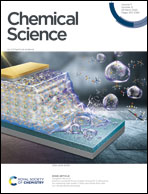Fc-binding antibody-recruiting molecules exploit endogenous antibodies for anti-tumor immune responses†
Abstract
Redirecting endogenous antibodies in the bloodstream to tumor cells using synthetic molecules is a promising approach to trigger anti-tumor immune responses. However, current molecular designs only enable the use of a small fraction of endogenous antibodies, limiting the therapeutic potential. Here, we report Fc-binding antibody-recruiting molecules (Fc-ARMs) as the first example addressing this issue. Fc-ARMs are composed of an Fc-binding peptide and a targeting ligand, enabling the exploitation of endogenous antibodies through constant affinity to the Fc region of antibodies, whose sequence is conserved in contrast to the Fab region. We show that Fc-ARM targeting folate receptor-α (FR-α) redirects a clinically used antibody mixture to FR-α+ cancer cells, resulting in cancer cell lysis by natural killer cells in vitro. Fc-ARMs successfully interacted with antibodies in vivo and accumulated in tumors. Furthermore, Fc-ARMs recruited antibodies to suppress tumor growth in a mouse model. Thus, Fc-ARMs have the potential to be a novel class of cancer immunotherapeutic agents.



 Please wait while we load your content...
Please wait while we load your content...